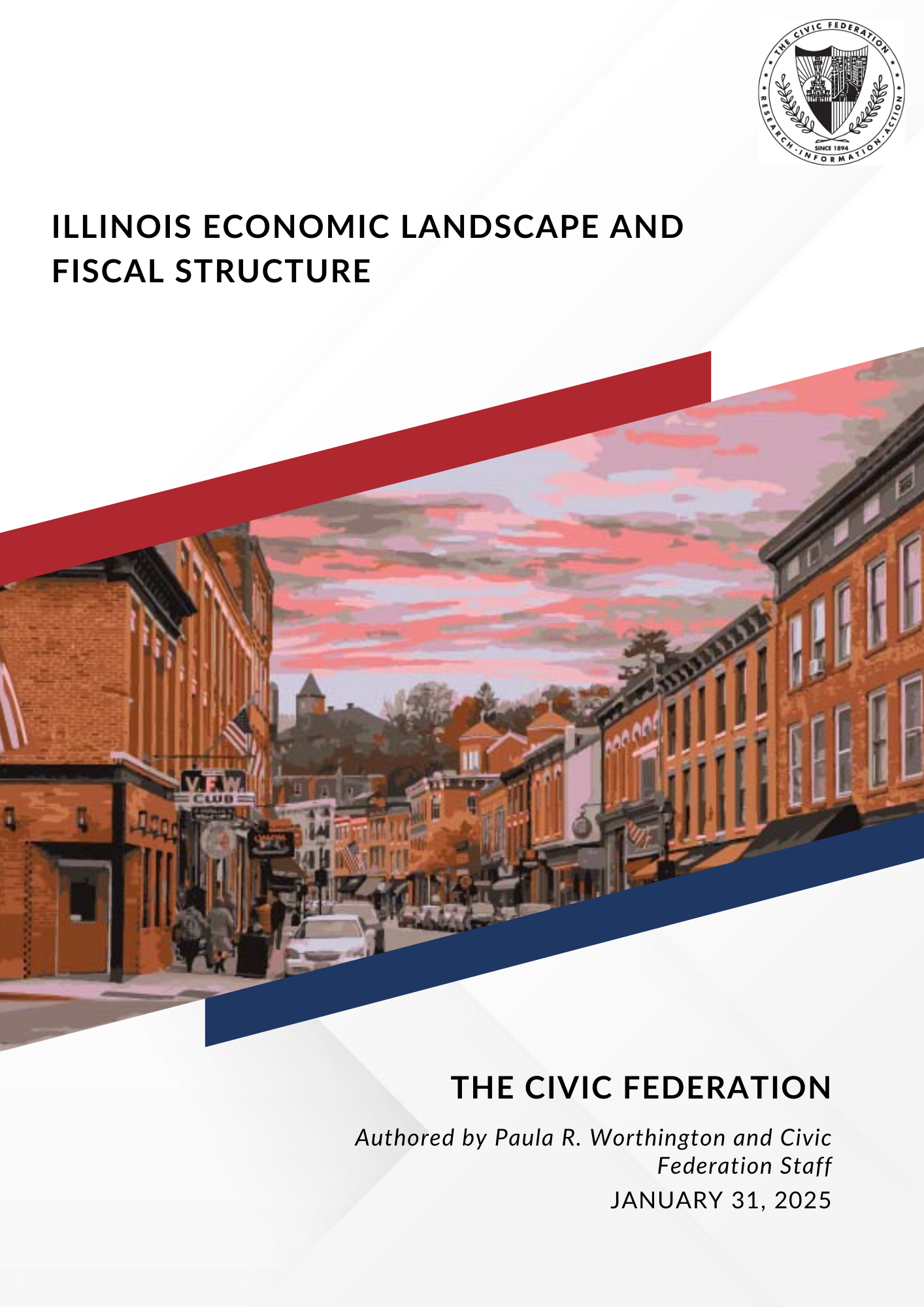January 31, 2025
Click here to read the full report.
Click here to read the one-pager.
Click here to view the infographic.
Executive Summary
Illinois’ fiscal policies significantly influence economic growth and employment in the state. How do those choices affect Illinois’ status as a top-tier place to “live, work, and do business,” and what specific fiscal factors appear most related to desired economic growth and investment state-wide? This report complements the Civic Federation’s upcoming State Budget Roadmap report by providing a substantive overview of Illinois’ economic landscape and fiscal structure, highlighting the state’s strengths and weaknesses, and exploring how fiscal policy choices impact future growth and prosperity.
Overall, this report paints a picture of a state with fundamental strengths (infrastructure, education, health care), “middle of the road” business and regulatory structures (minimum wage, regulations), and troubling fiscal conditions (high taxes, structural deficits, unfunded pension liabilities). To better understand Illinois’ current economic status, the analysis explores a number of economic, tax environment, and fiscal indicators as well as Illinois’ approach to economic development incentives. Key findings include:
- Economic Performance: Illinois underperforms in several economic metrics, including employment growth, output (as measured by gross domestic product, or GDP), and population growth.1
- Tax Burden and Business Climate: Illinois has a high tax burden for both personal and business taxes.
- Illinois is first among peer states in taxes paid per capita and taxes paid as a percentage of personal income.
- Illinois’ corporate income tax is the third highest in the nation, contributing to limited employment growth.
- Illinois’ tax system is also regressive, meaning lower-income residents pay a higher share of their income in state and local taxes than wealthier individuals.
- Economic Development Incentives: Despite offering a significant number of tax incentives that somewhat offset Illinois’ regressive tax system, there is little evidence that they effectively drive economic growth.
- Fiscal Stability and Challenges: Despite some recent fiscal improvements, Illinois’ fiscal stability remains a concern:
- Though the State recorded a surplus for the first time in 15 years in 2022, the end of pandemic-era funding and slowing economic activity and corresponding tax revenue threatens to reverse some of the recent progress made on the structural budget.
- Illinois’ “rainy day” fund, or reserves, is far below the national median, offering little protection against budget shocks.
- Pension obligations consume a significant portion of the State’s budget, which limits the ability to fund other services.
In short, Illinois' economic growth lags behind peer states and the nation, despite having strong economic fundamentals. As of November 2024, the state had the highest unemployment rate among its peers and weak employment growth, with job numbers barely above pre-pandemic levels. Illinois also struggles with slow GDP and population growth, relying on international immigration to offset continued domestic migration losses. A key factor in these trends is Illinois' high tax burden, which is among the highest in the country due to elevated property, sales, and income taxes, along with a narrow sales tax base. Additionally, the state’s economic development incentives and tax expenditures have increased significantly, yet there is little evidence that they effectively promote job creation or business growth, highlighting the need for better evaluation and strategic economic planning.
Finally, a number of weaknesses could inhibit the State’s economic growth, including high tax levels that impede competitiveness; an unclear understanding the impact of tax incentives; the fractured and duplicitous governmental structure in Illinois; local governments under fiscal duress; a shrinking higher education sector; and energy infrastructure needs.
With this report, the Civic Federation aims to build a shared understanding of Illinois’ current fiscal situation and foster productive future discussions about the state’s budgetary challenges, growth trajectory, and policy options.
[1] There are many tax codes in a community, so there will be different estimated effective property tax rates throughout a community, depending on school districts and other taxing bodies’ different tax rates.
Click here to read the full report.
Click here to read the one-pager.
Click here to view the infographic.

